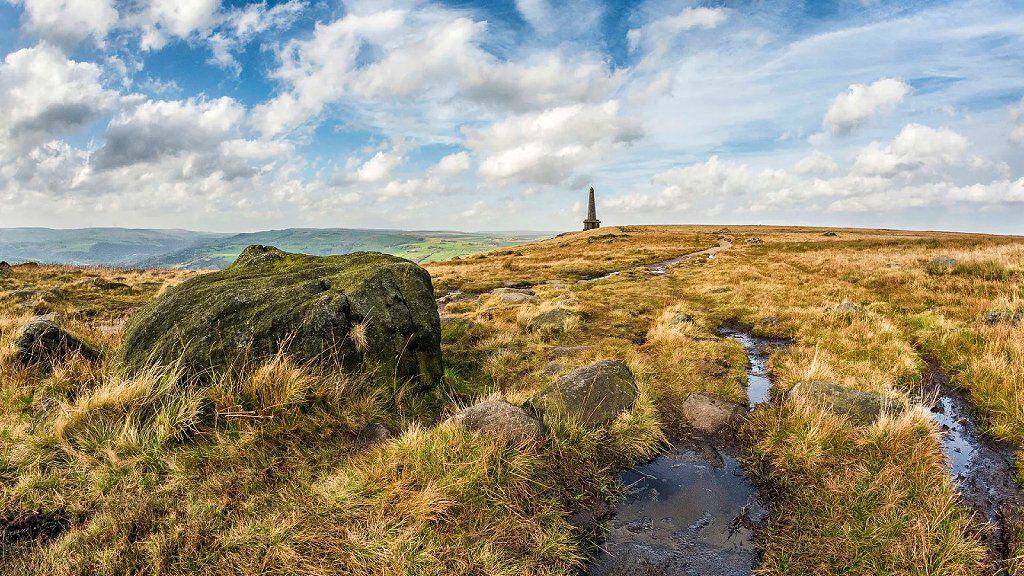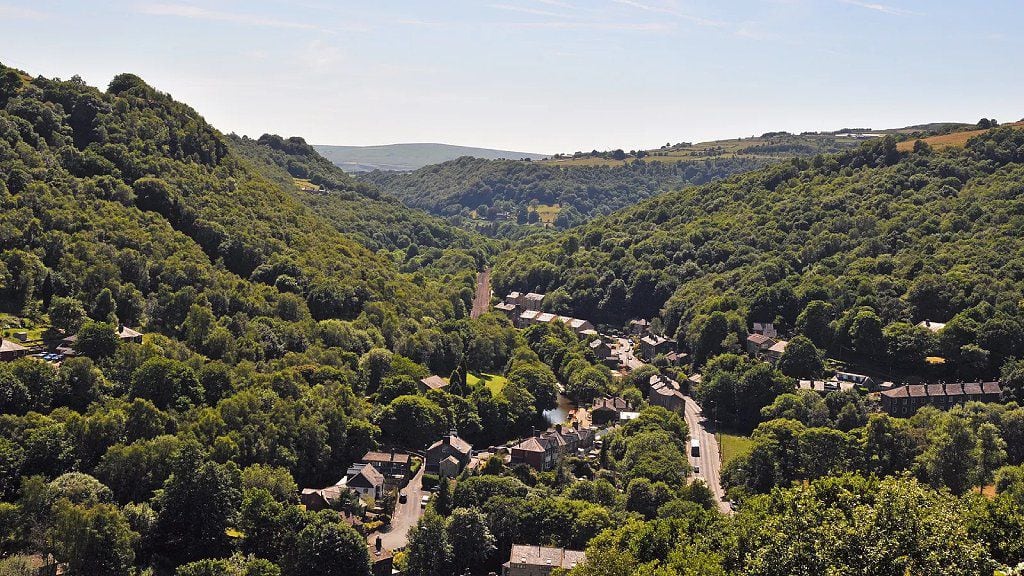February is as unpredictable as it is breathtaking in Cragg Vale, a town of cobbled streets and immense natural beauty in the sprawling countryside of West Yorkshire, England.
A week before he planned to hike a 5-mile trail known locally as the Coiners Trail, Cragg Vale was hit by two storms that left rivers swollen and trees uprooted in their wake.
Look: The tragic story of Patrice Lumumba, the assassinated Congolese leader with only one gold tooth left
But when I finally did, the skies were a pale blue and the hills glowed with burnt yellows and deep greens.
This is an imposing landscape that has largely remained unchanged over time; a handful of wind turbines dotted along the horizon are the only obvious markers of modern life.
I came to Cragg Vale to follow in the footsteps of ‘King’ David Hartley, who once forged a criminal empire in this part of Yorkshire, a county affectionately dubbed ‘God’s Own Country’.
I walked up steep forest-covered hills and wandered along bridle paths lined with wildflowers. The cabins on the slopes were nestled in the valleys, protected from the outside world. Birds sang, streams murmured, and sheep grazed on frost-covered fields.
These were the landscapes that inspired “Wuthering Heights” by Emily Brontë.
At first glance, there was little to suggest that this sprawling rural area was once home to a gang known as the Cragg Vale Coiners, whose 18th-century counterfeiting business took on the establishment and brought the Bank of England to its knees. .
At the time, due to trade between England, Spain, and Portugal, both English and foreign coins were accepted as legal tender in England.
Coins were made of valuable metals, more or less worth their weight in silver and gold.
The Coiners, led by Hartley, they trimmed the edges of these coins, shillings and moidores and melted them down to counterfeit coins.
Portuguese moidores were the most valuable, worth around 27 shillings a piece, roughly a week’s wages.
This company was not a small time operation.
For a time it was the biggest fraud in British history, with some estimates saying £3.5m of counterfeit coins were put into circulation, reducing the value of the coin by 9%. Today, that sum would be around 650 million pounds sterling (about $795 million).
While the gang members were known to murder those who annoyed them, they also enriched their community, and were protected by it, stealing from the rich to feed the poor locals, who would give David his nickname of “king”. .
Today, the story of Hartley has become a local legend and is almost folkloric in its infamy, in an enclave in the north of England that is full of strange stories and fantastic tales.
Perched atop a 1,300-foot hill in the upper Calder Valley, made up of small towns and villages, stands Stoodley Pike, a 120-foot spiked monument that was originally completed after the Battle of Waterloo, in 1815, as tribute to peace
By a calamitous coincidencewas capsized just before the Crimean War against Russia was declared in 1854.
Outside farms and churches are centuries-old human heads carved in stone, once thought who protected magical spirits.
Todmorden, meanwhile, is a hotbed of alien conspiracies and alleged UFO sightings, fueled primarily by the 1980 death of coal worker Zigmund Adamski, who was discovered more than 20 miles from his home covered in an unidentifiable sticky substance.
Your case remains unsolved.

“The perfect conditions for folklore is an area where there are separate communities with good communication with each other, economic interdependence and a distinctive landscape,” said John Billingsley, author and folklore historian.
“They all live close enough that they meet in pubs,” he continued. “That keeps the stories going and gives a sense of identity.”
“The Coiners hit hard with those who profited from their ‘Robin Hood’ work.”
Opinion is divided when it comes to remembering the Coiners. Some believe that they were simply products of their times, tough men for tough times. Others, who were nothing more than criminals.
“All societies have their outlawssaid Steve Tilston, a Hebden Bridge local and folk musician.
“[Los forajidos] they are not just villains but they manage to make fun of the people in charge, and that feeds legends. And in Hartley’s day, corruption was rife. Like now”.
Calder Valley’s landscape, like some of its attitudes, has remained largely untouched since Hartley was alive.
In 2018, local cartographer Chris Goddard devised “the Coiners Trail,” encompassing many of the gang’s frequented locations, some based on historical fact, others mythologized by Goddard on his many walks through the Calder landscape.

Our ride started at Mytholmroyd, where the gang used to make plans over beer. From there, we made our way through dense ancient forest, dredging steep slopes and wading through fallen leaves.
We wandered past a small pond unofficially known as ‘David’s Pool’, where the gang leader may have once bathed, and about a mile later we reached the vast moors of Broadhead Clough.
Alone, at the top of the hill, I was Bell House, Hartley’s original home and largely the gang’s illegal hub.
“From here, Hartley could see everything,” says Goddard, particularly from Lumb Hole Falls, a giant rock that dominates the valley, which is very close to the Bell House.
On our way there, we met a woman who, when we mentioned the Coiners to her, said: “You did a very good job: you brought down the treasury in London… someone had to do it.”
“Those from here could eat meat and dress properly,” he added. “They say they were tough, but it was a tough time. Good for him. I would have done the same thing. It was survival.”

The gang’s riches grew too large for higher powers to ignore.
The final straw came on November 8, 1769, when several members of the Coiners murdered an excise officer, William Deighton, sent to investigate them.
Five days later, a royal proclamation issued a £100 reward for whoever named the perpetrators.
Dozens of arrests were made, and the group began to implode. The members clashed with each other to save themselves.
Some escaped justice, like David’s brother Isaac, who died in his 70s or 80s.
Hartley was arrested. And on April 28, 1770, he was hanged at Knavesmire Tyburn, near the city of York.
For reasons unknown, Hartley was given a burial that would not befit a person sentenced to death in the 18th century, a time when criminals could be hanged, drawn, and quartered.
Following the execution, his body was released from York and transported 60 miles to St Thomas à Becket Church in Heptonstall, West Yorkshire, where he was buried in the consecrated church grounds.
The church, built between 1256 and 1260, is today a roofless ruin.
The poet Sylvia Plath is buried in the same cemetery; when I visited, her grave was adorned with flowers and the floor pierced with pens and pencils left in her honor.
Hartley’s was little more than a stone on the ground.
But Hartley’s name lives on, both in stone and in his descendants..
“Legendary is probably a good word for him,” said Steve Hartley, a five-time great-grandson of David Hartley.

Steve’s family history was controversial growing up, and he recalls that his great-grandfather rarely spoke of “king”.
“The older generations were embarrassed.”
Not just the above. Tilston recalls being told by a Heptonstall museum curator that Hartley was unworthy to be buried in the church.
But his story will soon be better known, thanks to a television adaptation of the Benjamin Myers novel”The Gallows Pole“, a partially fictional account of the Coiners.
Revered or reviled, there is something inherently human about why his story continues to be told, according to Billingsley.
“Folklore has a great capacity to attract people“, said. “It’s a search for origin and a validation of where you come from, and in the community today there are people looking for meaning and connection.”
Source: Elcomercio
I, Ronald Payne, am a journalist and author who dedicated his life to telling the stories that need to be said. I have over 7 years of experience as a reporter and editor, covering everything from politics to business to crime.

:quality(75)/cloudfront-us-east-1.images.arcpublishing.com/elcomercio/GE3TCMRNGA3C2MRWKQYDAORRG4.jpg)

:quality(75)/cloudfront-us-east-1.images.arcpublishing.com/elcomercio/KFEEC47ZU5DTJMBIGBDGW5K4CY.jpg)
:quality(75)/cloudfront-us-east-1.images.arcpublishing.com/elcomercio/VU3MHVTEKJCUNLUBFK6BQ4BK5Y.jpg)
:quality(75)/cloudfront-us-east-1.images.arcpublishing.com/elcomercio/6ABKCLPO2ZHDXEENFTFWWK2DLY.jpg)
:quality(75)/cloudfront-us-east-1.images.arcpublishing.com/elcomercio/BMKKVFZ2NJESRMJT7LZSH6OHW4.png)
